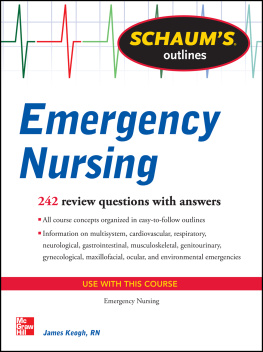SCHAUMS Outline
Medical Terminology
SCHAUMS Outline
Medical Terminology
Jim Keogh, R.N.
Instructor, New York University
Schaums Outline Series

This book is dedicated to Anne, Sandy, Joanne, Amber-Leigh Christine, Shawn and Eric, without whose help and support this book couldnt have been written.
JIM KEOGH is a registered nurse and has written Schaums Outline of Pharmacology, Schaums Outline of Nursing Laboratory and Diagnostic Tests, Schaums Outline of Medical Charting, and co-authored Schaums Outline of ECG Interpretation. His books can be found in leading university libraries including Yale University School of Medicine, University of Pennsylvania Biomedical Library, Columbia University, Brown University, University of Medicine and Dentistry of New Jersey, Cambridge University, and Oxford University. Jim Keogh, RN, AAS, MBA, is a former member of the faculty at Columbia University and is a member of the faculty of New York University.

Copyright 2011 by The McGraw-Hill Companies, Inc. All rights reserved. Except as permitted under the United States Copyright Act of 1976, no part of this publication may be reproduced or distributed in any form or by any means, or stored in a database or retrieval system, without the prior written permission of the publisher.
ISBN: 978-0-07-173653-4
MHID: 0-07-173653-0
The material in this eBook also appears in the print version of this title: ISBN: 978-0-07-173652-7, MHID: 0-07-173652-2.
All trademarks are trademarks of their respective owners. Rather than put a trademark symbol after every occurrence of a trademarked name, we use names in an editorial fashion only, and to the benefit of the trademark owner, with no intention of infringement of the trademark. Where such designations appear in this book, they have been printed with initial caps.
McGraw-Hill eBooks are available at special quantity discounts to use as premiums and sales promotions, or for use in corporate training programs. To contact a representative please e-mail us at bulksales@mcgraw-hill.com.
This publication is designed to provide accurate and authoritative information in regard to the subject matter covered. It is sold with the understanding that neither the author nor the publisher is engaged in rendering legal, accounting, futures/securities trading, or other professional service. If legal advice or other expert assistance is required, the services of a competent professional person should be sought.
From a Declaration of Principles jointly adopted by a Committee of the American Bar Association and a Committee of Publishers
TERMS OF USE
This is a copyrighted work and The McGraw-Hill Companies, Inc. (McGraw-Hill) and its licensors reserve all rights in and to the work. Use of this work is subject to these terms. Except as permitted under the Copyright Act of 1976 and the right to store and retrieve one copy of the work, you may not decompile, disassemble, reverse engineer, reproduce, modify, create derivative works based upon, transmit, distribute, disseminate, sell, publish or sublicense the work or any part of it without McGraw-Hills prior consent. You may use the work for your own noncommercial and personal use; any other use of the work is strictly prohibited. Your right to use the work may be terminated if you fail to comply with these terms.
THE WORK IS PROVIDED AS IS. McGRAW-HILL AND ITS LICENSORS MAKE NO GUARANTEES OR WARRANTIES AS TO THE ACCURACY, ADEQUACY OR COMPLETENESS OF OR RESULTS TO BE OBTAINED FROM USING THE WORK, INCLUDING ANY INFORMATION THAT CAN BE ACCESSED THROUGH THE WORK VIA HYPERLINK OR OTHERWISE, AND EXPRESSLY DISCLAIM ANY WARRANTY, EXPRESS OR IMPLIED, INCLUDING BUT NOT LIMITED TO IMPLIED WARRANTIES OF MERCHANTABILITY OR FITNESS FOR A PARTICULAR PURPOSE. McGraw-Hill and its licensors do not warrant or guarantee that the functions contained in the work will meet your requirements or that its operation will be uninterrupted or error free. Neither McGraw-Hill nor its licensors shall be liable to you or anyone else for any inaccuracy, error or omission, regardless of cause, in the work or for any damages resulting there from. McGraw-Hill has no responsibility for the content of any information accessed through the work. Under no circumstances shall McGraw-Hill and/or its licensors be liable for any indirect, incidental, special, punitive, consequential or similar damages that result from the use of or inability to use the work, even if any of them has been advised of the possibility of such damages. This limitation of liability shall apply to any claim or cause whatsoever whether such claim or cause arises in contract, tort or otherwise.
Contents
23.18 Rheumatic Heart Disease
CHAPTER 1
The Language of Medicine
1.1 Definition
At first, medical terminology might seem a foreign language that consists of long, hard-to-pronounce words that even health care providers sometimes have difficulty pronouncing. However, another way to think of medical terminology is like a secret message that becomes clear once you decode the message.
The first step in deciphering a medical term is to break it down into its components:
Root: Each medical term has one or more roots that specify the subject of the term.
Suffix: Each medical term has a suffix, which is the ending of the term that describes an aspect of the subject.
Vowel: Most medical terms have a vowel whose sole purpose is to link the root and suffix. The vowel is usually an o.
Prefix: Many medical terms have a prefix at the beginning of the term that modifies the root.
Combining Form: The combining form is assembling the prefix, root, vowel, and suffix to form the medical term.
Reading a Medical Term
In order to read and understand a medical term, you need to learn the definitions of prefixes, roots, and suffixes, which you will learn through this chapter. Begin reading the medical term by identifying the root. The root usually identifies the part of the body. Next, read the suffix of the medical term. The suffix is at the end of the term and usually identifies the action. And then read the prefix of the medical term, if there is one. The prefix usually narrows the term to a particular aspect of the root.
Example: Epigastric
Root: The root of epigastric is gastr. Think of gastr as the vcode word for stomach. Each time you see gastr in the medical term, you know that the term has something to do with the stomach.
Suffix: The suffix of epigastric is ic. Think of ic as the code word for pertaining to something, which is usually the root. In this example, the medical term is pertaining to the stomach.
Prefix: The prefix in epigastric is epi. Think of epi as the code word for above. Each time you see epi in the medical term, you know that term refers to above the root, which in this example refers to above the stomach.
Reading a Medical Term in a Sentence
Next page




